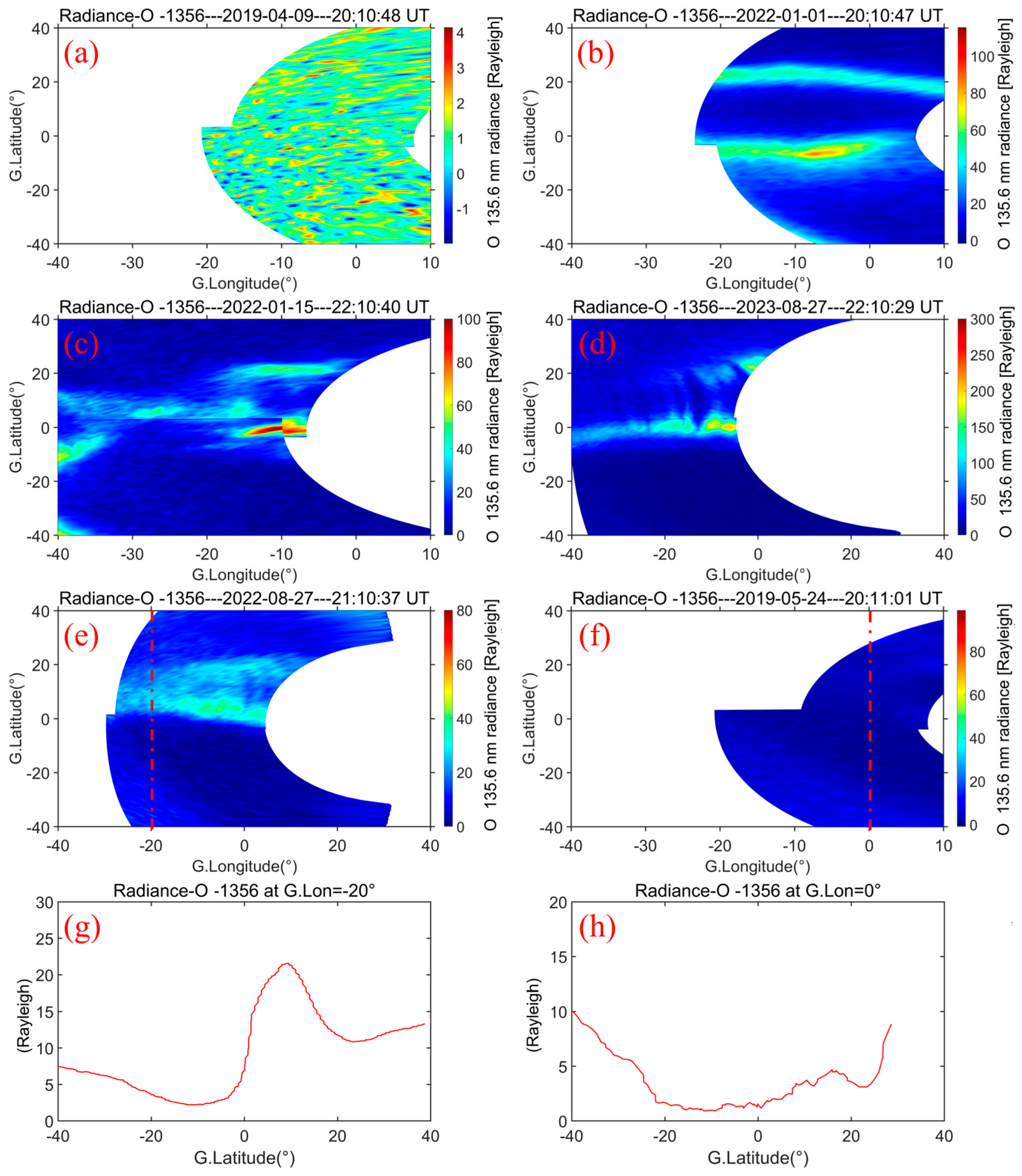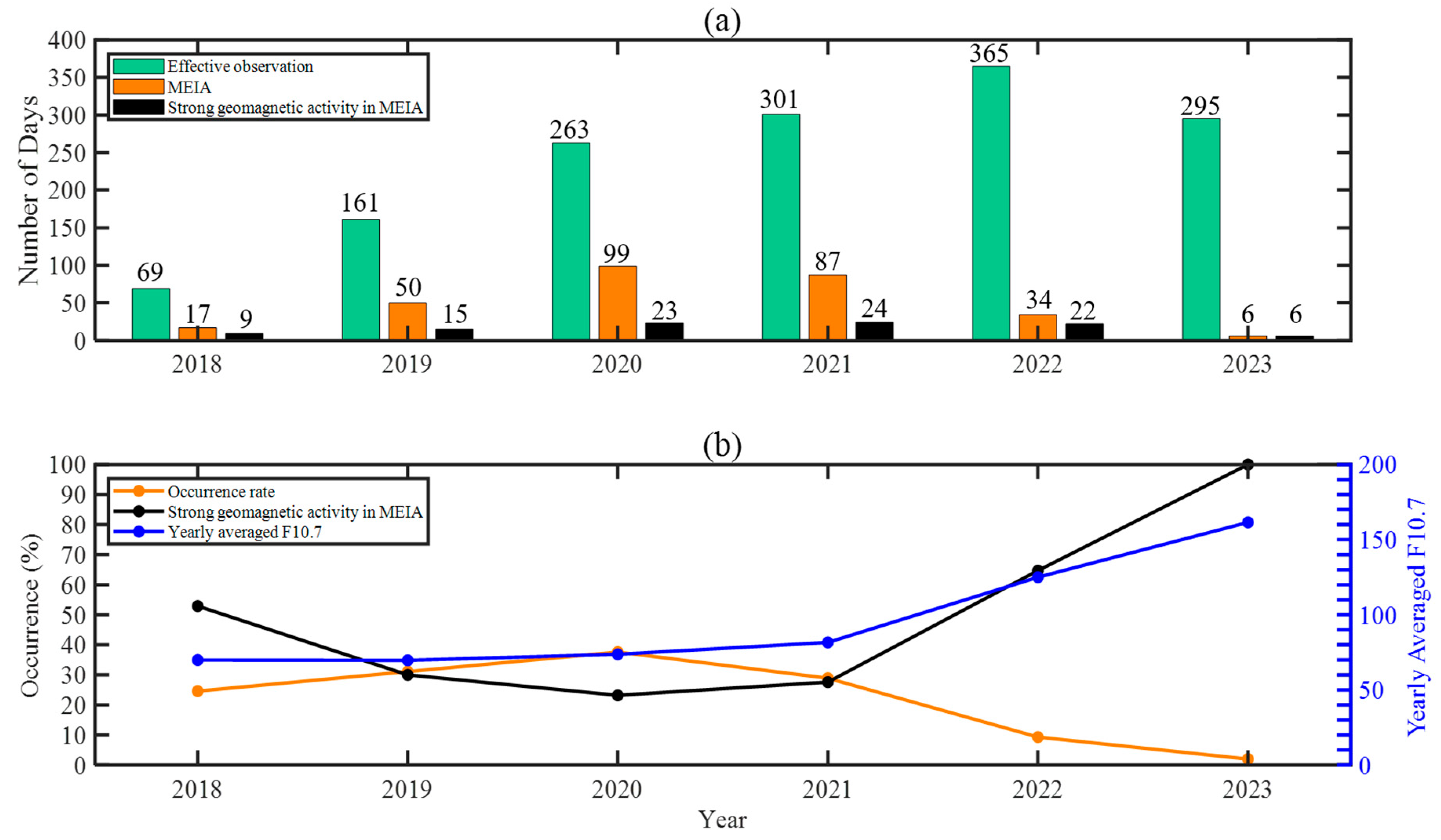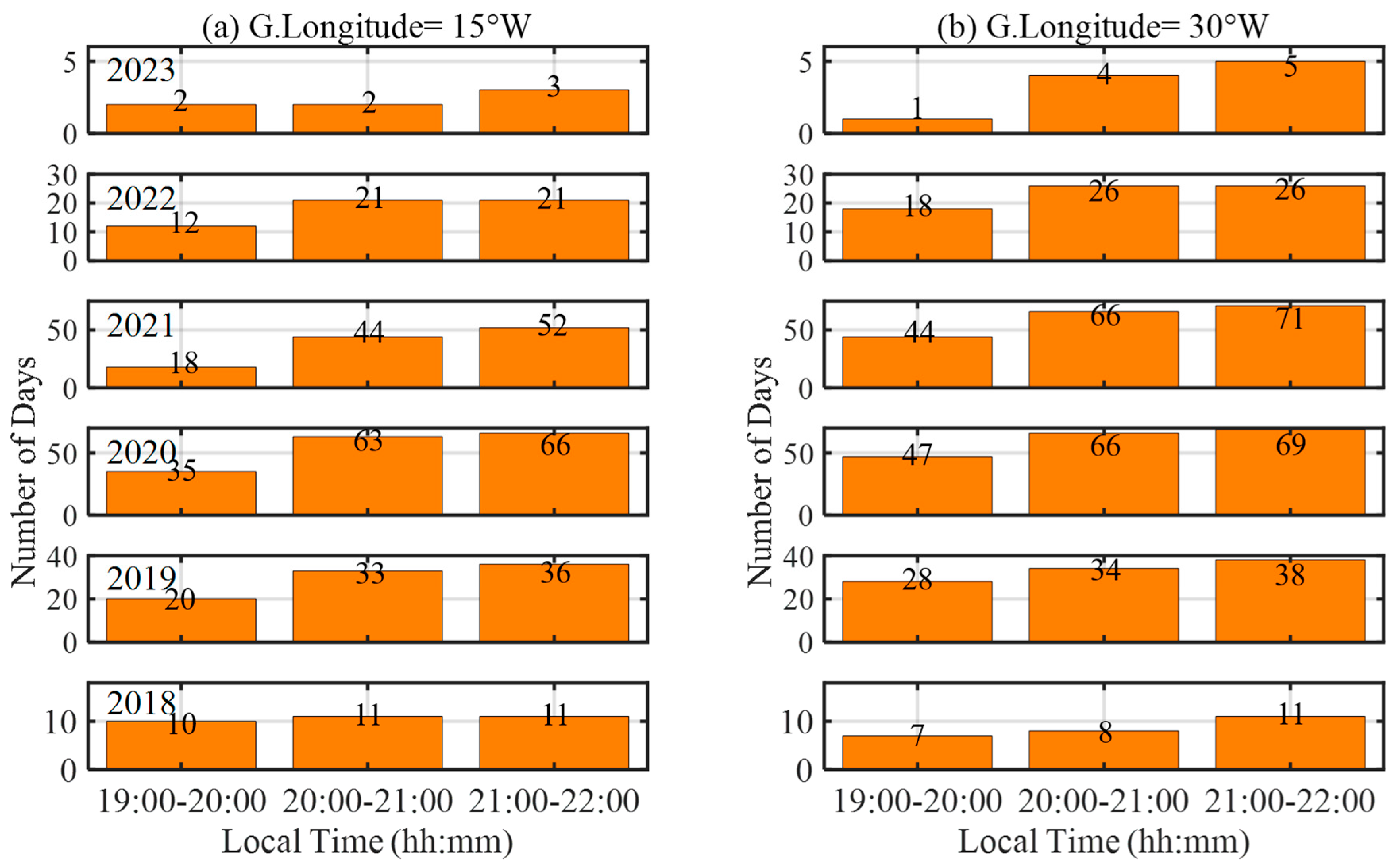Occurrence Characteristics of Nighttime Merged EIA Based on NASA GOLD Observations from 2018 to 2023
Abstract
1. Introduction
2. Datasets and Statistical Analysis Methods
3. Results
4. Discussion
5. Conclusions
Supplementary Materials
Author Contributions
Funding
Data Availability Statement
Acknowledgments
Conflicts of Interest
References
- Appleton, E.V. Two anomalies in the ionosphere. Nature 1946, 157, 691. [Google Scholar] [CrossRef]
- Croom, S.; Robbins, A.; Thomas, J.O. Two anomalies in the behaviour of the F2 layer of the ionosphere. Nature 1959, 184, 2003–2004. [Google Scholar] [CrossRef]
- Duncan, R.A. The equatorial f-region of the ionosphere. J. Atmos. Terr. Phys. 1960, 18, 89–100. [Google Scholar] [CrossRef]
- Anderson, D.N. A theoretical study of the ionospheric F region equatorial anomaly—I. Theory. Planet. Space Sci. 1973, 21, 409–419. [Google Scholar] [CrossRef]
- Balan, N.; Liu, L.; Le, H. A brief review of equatorial ionization anomaly and ionospheric irregularities. Earth Planet. Phys. 2018, 2, 257–275. [Google Scholar] [CrossRef]
- Balan, N.; Bailey, G.J.; Abdu, M.A.; Oyama, K.I.; Richards, P.G.; MacDougall, J.; Batista, I.S. Equatorial plasma fountain and its effects over three locations: Evidence for an additional layer, the F 3 layer. J. Geophys. Res. Space Phys. 1997, 102, 2047–2056. [Google Scholar] [CrossRef]
- Basu, S.; Huba, J.; Krall, J.; McDonald, S.E.; Makela, J.J.; Miller, E.S.; Ray, S.; Groves, K. Day-to-day variability of the equatorial ionization anomaly and scintillations at dusk observed by guvi and modeling by sami3. J. Geophys. Res. Space Phys. 2009, 114, A04302. [Google Scholar] [CrossRef]
- Zhang, M.-L.; Wan, W.; Liu, L.; Ning, B. Variability study of the crest-to-trough TEC ratio of the equatorial ionization anomaly around 120°E longitude. Adv. Space Res. 2009, 43, 1762–1769. [Google Scholar] [CrossRef]
- Khadka, S.M.; Valladares, C.E.; Sheehan, R.; Gerrard, A.J. Effects of electric field and neutral wind on the asymmetry of equatorial ionization anomaly. Radio Sci. 2018, 53, 683–697. [Google Scholar] [CrossRef]
- Cai, X.; Burns, A.G.; Wang, W.; Qian, L.; Liu, J.; Solomon, S.C.; Eastes, R.W.; Daniell, R.E.; Martinis, C.R.; McClintock, W.E.; et al. Observation of postsunset OI 135.6 nm radiance enhancement over South America by the GOLD mission. J. Geophys. Res. Space Phys. 2021, 126, e28108. [Google Scholar] [CrossRef]
- Cai, X.; Burns, A.G.; Wang, W.; Coster, A.; Qian, L.; Liu, J.; Solomon, S.C.; Eastes, R.W.; Daniell, R.E.; McClintock, W.E. Comparison of GOLD nighttime measurements with total electron content: Preliminary results. J. Geophys. Res. Space Phys. 2020, 125, e27767. [Google Scholar] [CrossRef]
- Zeng, Z.; Burns, A.; Wang, W.; Lei, J.; Solomon, S.; Syndergaard, S.; Qian, L.; Kuo, Y.-H. Ionospheric annual asymmetry observed by the COS-MIC radio occultation measurements and simulated by the TIEGCM. J. Geophys. Res. 2008, 113, A07305. [Google Scholar] [CrossRef]
- Dang, T.; Luan, X.; Lei, J.; Dou, X.; Wan, W. A numerical study of the interhemispheric asymmetry of the equatorial ionization anomaly in solstice at solar minimum. J. Geophys. Res. Space Phys. 2016, 121, 9099–9110. [Google Scholar] [CrossRef]
- Cai, X.; Qian, L.; Wang, W.; McInerney, J.M.; Liu, H.; Eastes, R.W. Investigation of the post-sunset extra electron density peak poleward of the equatorial ionization anomaly southern crest. J. Geophys. Res. Space Phys. 2022, 127, e2022JA030755. [Google Scholar] [CrossRef]
- Wu, K.; Qian, L.; Wang, W.; Cai, X.; Mclnerney, J.M. Investigation of the GOLD observed merged nighttime EIA with WACCM-X simulations during the storm of 3 and 4 November 2021. Geophys. Res. Lett. 2023, 50, e2023GL103603. [Google Scholar] [CrossRef]
- Carruthers, G.R.; Page, T. Apollo 16 far-ultraviolet camera/spectrograph: Earth observations. Science 1972, 177, 788–791. [Google Scholar] [CrossRef] [PubMed]
- Huang, C.M.; Chen, M.Q.; Liu, J.Y. Ionospheric positive storm phases at the magnetic equator close to sunset. J. Geophys. Res. 2010, 115, A07315. [Google Scholar] [CrossRef]
- Balan, N.; Yamamoto, M.; Liu, J.Y.; Otsuka, Y.; Liu, H.; Lühr, H. New aspects of thermospheric and ionospheric storms revealed by CHAMP. J. Geophys. Res. Space Phys. 2011, 116, A07305. [Google Scholar] [CrossRef]
- Balan, N.; Otsuka, Y.; Nishioka, M.; Liu, J.Y.; Bailey, G.J. Physical mechanisms of the ionospheric storms at equatorial and higher latitudes during the recovery phase of geomagnetic storms. J. Geophys. Res. Space Phys. 2013, 118, 2660–2669. [Google Scholar] [CrossRef]
- Huang, L.; Wang, J.; Jiang, Y.; Huang, J.; Chen, Z.; Zhao, K. A preliminary study of the single crest phenomenon in total electron content (TEC) in the equatorial anomaly region around 120 E longitude between 1999 and 2012. Adv. Space Res. 2014, 54, 2200–2207. [Google Scholar] [CrossRef]
- Aa, E.; Zhang, S.; Wang, W.; Erickson, P.J.; Qian, L.; Eastes, R.; Harding, B.J.; Immel, T.J.; Karan, D.K.; Daniell, R.E.; et al. Pronounced suppression and X-pattern merging of equatorial ionization anomalies after the 2022 Tonga volcano eruption. J. Geophys. Res. Space Phys. 2022, 127, e2022JA030527. [Google Scholar] [CrossRef] [PubMed]
- Fathy, A.; Ghamry, E. A statistical study of single crest phenomenon in the equatorial ionospheric anomaly region using Swarm A satellite. Adv. Space Res. 2017, 59, 1539–1547. [Google Scholar] [CrossRef]
- Hussien, F.; Ghamry, E.; Mohammed, Y.; Fathy, A. Ionospheric single crest events at different altitudes and activity levels observed by Swarm constellation. Astrophys. Space Sci. 2023, 368, 25. [Google Scholar] [CrossRef]
- Eastes, R.W.; Solomon, S.C.; Daniell, R.E.; Anderson, D.N.; Burns, A.G.; England, S.L.; Martinis, C.R.; McClintock, W.E. Global-scale observations of the equatorial ionization anomaly. Geophys. Res. Lett. 2019, 46, 9318–9326. [Google Scholar] [CrossRef]
- Eastes, R.W.; McClintock, W.E.; Burns, A.G.; Anderson, D.N.; Andersson, L.; Codrescu, M.; Correira, J.T.; Daniell, R.E.; England, S.L.; Evans, J.S.; et al. The global-scale observations of the limb and disk (GOLD) mission. Space Sci. Rev. 2017, 212, 383–408. [Google Scholar] [CrossRef]
- Karan, D.K.; Daniell, R.E.; England, S.L.; Martinis, C.R.; Eastes, R.W.; Burns, A.G.; McClintock, W.E. First zonal drift velocity measurement of equatorial plasma bubbles (EPBs) from a geostationary orbit using GOLD data. J. Geophys. Res. Space Phys. 2020, 125, e2020JA028173. [Google Scholar] [CrossRef]
- McClintock, W.E.; Eastes, R.W.; Hoskins, A.C.; Siegmund, O.H.W.; McPhate, J.B.; Krywonos, A.; Solomon, S.C.; Burns, A.G. Global-scale observations of the limb and disk mission implementation: 2. Observations, data pipeline, and level 1 data products. J. Geophys. Res. Space Phys. 2020, 125, e2020JA027809. [Google Scholar] [CrossRef]
- Heelis, R.A.; Coley, W.R.; Burrell, A.G.; Hairston, M.R.; Earle, G.D.; Perdue, M.D.; Power, R.A.; Harmon, L.L.; Holt, B.J.; Lippincott, C.R. Behavior of the O+/H+ transition height during the extreme solar minimum of 2008. Geophys. Res. Lett. 2009, 36, L00C03. [Google Scholar] [CrossRef]
- Liu, L.; Chen, Y.; Le, H.; Kurkin, V.I.; Polekh, N.M.; Lee, C.-C. The ionosphere under extremely prolonged low solar activity. J. Geophys. Res. Space Phys. 2011, 116, A04320. [Google Scholar] [CrossRef]
- Nanan, B.; Chen, C.Y.; Rajesh, P.K.; Liu, J.Y.; Bailey, G.J. Modeling and observations of the low latitude ionosphere-plasmasphere system at long deep solar minimum. J. Geophys. Res. Space Phys. 2012, 117, A08316. [Google Scholar] [CrossRef]
- Fejer, B.G.; Farley, D.T.; Woodman, R.; Calderon, C. Dependence of equatorial F region vertical drifts on season and solar cycle. J. Geophys. Res. Space Phys. 1979, 84, 5792–5796. [Google Scholar] [CrossRef]
- Batista, I.S.; de Medeiros, R.T.; Abdu, M.A.; de Souza, J.R.; Bailey, G.J.; de Paula, E.R. Equatorial ionospheric vertical plasma drift model over the Brazilian region. J. Geophys. Res. Space Phys. 1996, 101, 10887–10892. [Google Scholar] [CrossRef]
- Abdu, M.A.; Batista, I.S.; Reinisch, B.W.; Sobral, J.H.A.; Carrasco, A.J. Equatorial F region evening vertical drift, and peak height, during southern winter months: A comparison of observational data with the IRI descriptions. Adv. Space Res. 2006, 37, 1007–1017. [Google Scholar] [CrossRef]
- Liu, J.; Zhang, D.; Mo, X.; Xiong, C.; Hao, Y.; Xiao, Z. Morphological differences of the northern equatorial ionization anomaly between the eastern Asian and American sectors. J. of Geophys. Res. 2020, 125, e2019JA027506. [Google Scholar] [CrossRef]
- Tsai, H.; Liu, J.; Tsai, W.; Liu, C.; Tseng, C.; Wu, C. Seasonal variations of the ionospheric total electron content in Asian equatorial anomaly regions. J. Geophys. Res. 2001, 106, 30363–30369. [Google Scholar] [CrossRef]
- Huang, Y.; Cheng, K. Solar cycle variations of the equatorial ionospheric anomaly in total electron content in the Asian region. J. Geophys. Res. 1996, 101, 24513–24520. [Google Scholar] [CrossRef]
- Fejer, B.G.; de Paula, E.R.; Heelis, R.A.; Hanson, W.B. Global equatorial ionospheric vertical plasma drifts measured by the AE-E satellite. J. Geophys. Res. Space Phys. 1996, 100, 5769–5776. [Google Scholar] [CrossRef]
- Burns, A.G.; Solomon, S.C.; Wang, W.; Qian, L.; Zhang, Y.; Paxton, L.J. Daytime climatology of ionospheric NmF2 and hmF2 from COSMIC data. J. Geophys. Res. 2012, 117, A09315. [Google Scholar] [CrossRef]
- Qian, L.; Burns, A.G.; Solomon, S.C.; Wang, W. Annual/semiannual variation of the ionosphere. Geophys. Res. Lett. 2013, 40, 1928–1933. [Google Scholar] [CrossRef]
- Farley, D.T.; Bonelli, E.; Fejer, B.G.; Larsen, M.F. The prereversal enhancement of the zonal electric field in the equatorial ionosphere. J. Geophys. Res. Atmos. 1986, 91, 13723–13728. [Google Scholar] [CrossRef]
- Millward, G.H.; Müller-Wodarg, I.C.F.; Aylward, A.D.; Fuller-Rowell, T.J.; Richmond, A.D.; Moffett, R.J. An investigation into the influence of tidal forcing on f region equatorial vertical ion drift using a global ionosphere-thermosphere model with coupled electrodynamics. J. Geophys. Res. Space Phys. 2001, 106, 24733–24744. [Google Scholar] [CrossRef]
- Mathew, T.J.; Nayar, S. Vertical shear at the equatorial f-region ionosphere during post-sunset hours. Adv. Space Res. 2012, 49, 1277–1281. [Google Scholar] [CrossRef]
- Abdu, M.A.; Batista, I.S.; Takahashi, H.; MacDougall, J.; Sobral, J.H.; Medeiros, A.F.; Trivedi, N.B. Magnetospheric disturbance Induced equatorial plasma bubble development and dynamics: A case study in Brazilian sector. J. Geophys. Res. 2003, 108, 1449. [Google Scholar] [CrossRef]
- Basu, S.; Basu, S.; Rich, F.J.; Groves, K.M.; MacKenzie, E.; Coker, C.; Sahai, Y.; Fagundes, P.R.; Becker-Guedes, F. Response of the equatorial ionosphere at dusk to penetration electric fields during intense magnetic storms. J. Geophys. Res. 2007, 112, A08308. [Google Scholar] [CrossRef]
- Tulasi Ram, S.; Rama Rao, P.V.S.; Prasad, D.S.V.V.D.; Niranjan, K.; Gopi Krishna, S.; Sridharan, R.; Ravindran, S. Local time dependent response of postsunset ESF during geomagnetic storms. J. Geophys. Res. 2008, 113, A07310. [Google Scholar] [CrossRef]
- Scherliess, L.; Fejer, B.G. Storm time dependence of equatorial disturbance dynamo zonal electric fields. J. Geophys. Res. 1997, 102, 24037–24046. [Google Scholar] [CrossRef]
- Li, G.; Ning, B.; Zhao, B.; Liu, L.; Wan, W.; Ding, F.; Xu, J.S.; Liu, J.Y.; Yumoto, K. Characterizing the 10 November 2004 storm-time middle-latitude plasma bubble event in Southeast Asia using multi-instrument observations. J. Geophys. Res. 2009, 114, A07304. [Google Scholar] [CrossRef]
- Ramsingh; Sripathi, S.; Sreekumar, S.; Banola, S.; Emperumal, K.; Tiwari, P.; Kumar, B.S. Low-latitude ionosphere response to super geomagnetic storm of 17/18 March 2015: Results from a chain of ground-based observations over Indian sector. J. Geophys. Res. Space Phys. 2015, 120, 10864–10882. [Google Scholar] [CrossRef]
- Carter, B.A.; Yizengaw, E.; Pradipta, R.; Retterer, J.M.; Groves, K.; Valladares, C.; Caton, R.; Bridgwood, C.; Norman, R.; Zhang, K. Global equatorial plasma bubble occurrence during the 2015 St. Patrick’s Day storm. J. Geophys. Res. Space Phys. 2016, 121, 894–905. [Google Scholar] [CrossRef]




Disclaimer/Publisher’s Note: The statements, opinions and data contained in all publications are solely those of the individual author(s) and contributor(s) and not of MDPI and/or the editor(s). MDPI and/or the editor(s) disclaim responsibility for any injury to people or property resulting from any ideas, methods, instructions or products referred to in the content. |
© 2024 by the authors. Licensee MDPI, Basel, Switzerland. This article is an open access article distributed under the terms and conditions of the Creative Commons Attribution (CC BY) license (https://creativecommons.org/licenses/by/4.0/).
Share and Cite
Wu, K.; Qian, L. Occurrence Characteristics of Nighttime Merged EIA Based on NASA GOLD Observations from 2018 to 2023. Remote Sens. 2024, 16, 1575. https://doi.org/10.3390/rs16091575
Wu K, Qian L. Occurrence Characteristics of Nighttime Merged EIA Based on NASA GOLD Observations from 2018 to 2023. Remote Sensing. 2024; 16(9):1575. https://doi.org/10.3390/rs16091575
Chicago/Turabian StyleWu, Kun, and Liying Qian. 2024. "Occurrence Characteristics of Nighttime Merged EIA Based on NASA GOLD Observations from 2018 to 2023" Remote Sensing 16, no. 9: 1575. https://doi.org/10.3390/rs16091575
APA StyleWu, K., & Qian, L. (2024). Occurrence Characteristics of Nighttime Merged EIA Based on NASA GOLD Observations from 2018 to 2023. Remote Sensing, 16(9), 1575. https://doi.org/10.3390/rs16091575




